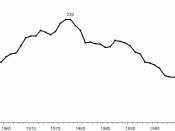Temporary Assistance for Needy Families or TANF
Temporary Assistance for Needy Families or TANF is a block grant that was created by the Personal Responsibility and Work Opportunity Reconciliation Act of 1996 and it was a part of a federal effort to "end welfare as we know it" (Friedman, 2006, p.3). The purpose of the TANF program is to provide temporary assistance for the care of dependent children in their own homes or the homes of relatives by providing financial, medical and self-sufficiency services (Gariepy, 2005).
Under TANF, the federal government provides block grants to the states, which use these funds to operate their own programs. Under TANF, states decide how much aid to provide to a needy family. The federal block grant for TANF is based on each state's peak level of federal expenditures for AFDC and related programs; for most states this was 1994 level (Gariepy, 2005). No federal guidelines exist for determining eligibility and no requirement asks that states help all needy families.
Though TANF does not require states to have a need standard or a gross income limit, as did AFDC, many states have based their programs in part on their earlier practices (Gariepy, 2005). The maximum benefit is the amount paid to a family with no countable income. Federal law specifies what income counts toward figuring benefits and what income is to be disregarded by the state. The maximum benefit is paid only to those families that comply with TANF's work requirement (Gariepy, 2005).
Even though TANF is called a block grant program, it actually combines seven different grants, and each grant has limited maximums. These grants are state-family assistance grant, bonuses to reward decreases in illegitimacy, supplemental grants for population increases in certain states, bonuses to reward high-performance states, welfare to work formula...


